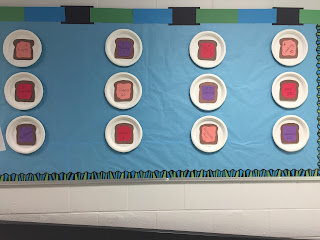So when we came back for preplanning week at the end of July, I felt a bit of pressure to create something just as wonderful for this school year. I admit that I googled and looked for bulletin board ideas, but none of them really caught my fancy. Don't ask me how, but I came up with the saying "Music is my Jam!" with the added on notion, "Spread it around," meaning to share it with others. I created a jam jar labeled "MUSIC", a knife with blobs of jam and a dozen plates with slices of bread and different kinds of "jam" (e.g. compose, sing, etc.). Here it is:
I received many compliments on my work and that should be enough, right? But after the first couple weeks of school, the notion of a musical jam session stuck with me and I just had to find a way to turn this into a lesson with my students. Here is the breakdown of what we did and a few examples of student work.
First, we used the natural rhythm of the phrases "Music is my jam" and "Spread it around" and practiced it on our hands:
Then we transferred the hand motions to a partner drumming activity: one partner held a hand drum while the other had a pair of mallets and played the first part. During the "spread it around part" the drum holder rubbed the drum head with his hands while they all turned around to face a new partner. This became our A section.
But wait - there's more! I wanted my students to have some creative the chance to create small music "jams" of their own. Enter rhythmic building blocks. For those of you who don't know, Carl Orff's colleague and co-creator of the Schulwerk Gunild Keetman came up with the notion of rhythmic building blocks. These are small (2 beat) permutations of rhythm that can be combined together to create larger rhythmic pieces. In Orff practice, we use building blocks along with speech to enable student success when they are creating or improvising. In this case, I went straight to the Smuckers website to see what flavors of jam they made. Ah yes, the things a music teacher will do! After a bit of research, these are the flavors I found to fit:
plum, mango, concord grape, strawberry, boysenberry
After familiarizing ourselves with each building block and practicing how to combine them into four beat phrases, students worked in groups of four (or so) with the task of: choose two jam flavors to create an ostinato and figure out how you will perform it. I encouraged students to incorporate movement or use different ways of holding or playing the drums. Here are a couple of their ideas:
Incorporating movement with partners.
Finding a new way to play drums.
I hope you enjoy these ideas and they inspire you to find your own musical jam. Spread it around!





No comments:
Post a Comment